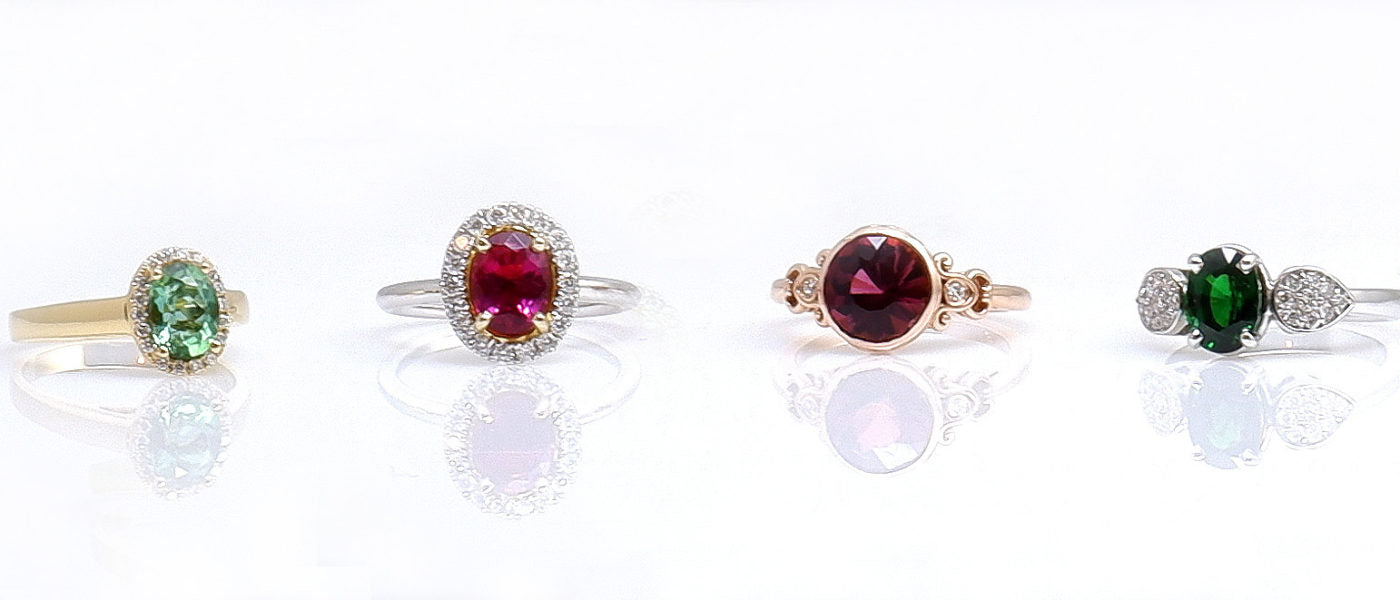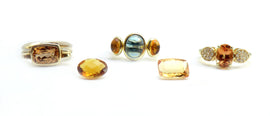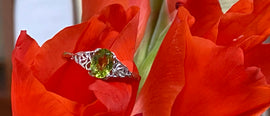People born in the month of October are lucky to have both Opal and Tourmaline to be called their birthstone. Each gemstone carries different varieties and color options. Read on to learn a bit more of these intriguing gemstones.
Opals are the most popular phenomenal gem. It’s thought to be the most “magical” of all gems, because some have the ability to display all colors in one stone. The Greeks believed the opals had the “power of foresight and prophecy” while Arabians believed opals were sent from the “heavens” to earth through “lightning.”
Opals are mostly cut and presented in jewelry with a cabochon style finish. Fire opals are often faceted but can also be finished in a cabochon style. Opals measure on the Mohs hardness scale between 5 ½ to 6 ½ . It’s recommended to wear jewelry containing opals, with extra care. Care for your opals is to simply avoid exposure to harsh chemicals, detergents, and extreme temperature changes in a short time frame, like reaching in a freezer on a hot summer day, if your opal is set into a ring.
Opals always contain water in its molecular construction, which contributes to it’s phenomenal “play-of-color.” If the opal looses the moisture in the stone, the beauty of the stone will diminish. To help prevent this from happening, it’s good to soak the opals in an oil or water and to clean with mild water to avoid cracks and crazing from harsh chemicals and heat.
Opals come in many varieties, but the four common categories for this gemstone are “White” opals which are translucent to semi-translucent with white to light gray body color. “Black” opals are translucent to opaque with black or a dark body color. “Fire” opals are transparent to translucent with brown, yellow, orange or red body color. Lastly, “Boulder” opals are translucent to opaque with light to dark body color which include fragments of host rock, or matrix as part of the finished gem. All of these varieties will carry a form of play-of-color. All good quality varieties of opals will have a unique pattern of “play-of-color.”
The Gemological Institute of America tells us alternative trade terms for an opal’s “play-of-color” pattern described as follows:
- Pinfire or Pinpoint show small, close-set patches of color
- Harlequin or mosaic contain broad angular, close-set patches of color
- Flame patterns will have a sweeping reddish bands or streaks the shoot across the stone
- Peacock opals are mainly blue and green in color
What is “play-of-color” and how does it occur? The science behind play-of-color is simply the “sub-microscopic” spheres of silica (silicon dioxide). These spheres are stacked in a grid-like pattern. The light enters the opal, each individual sphere of silica, will break up the light and return to the viewer different spectral colors and patterns within the opal. The more the stone displays its play-of-color throughout the stone, the more valuable it becomes. Within the stone’s play-of-color, the most preferred dominant color is red, followed by orange, then green. All opals with distinct patterns and intense vibrant play-of-color are beautiful, if not mesmerizing. The best opals are mined from Lightning Ridge in Australia.
At Jonathan’s Jewelers, we offer a variety of opal gemstones that are set in jewelry or loose for you to create a piece of jewelry of your own.
October’s alternate birthstone is Tourmaline. Most people may associate tourmalines’ color as pink, however, like opal, tourmaline is available in a variety of colors. Ancient legend is said that tourmaline comes in a vast array of colors because it traveled along a rainbow. Some lore suggests tourmaline strengthens the body and spirit especially, the blood, and nervous system.
Tourmaline is a fairly durable stone to wear in jewelry. It measures 7-7 ½ on the Mohs hardness scale. The majority of tourmaline gemstones will be faceted, however, some tourmalines may have chatoyancy or a “cat’s eye” affect, or if a watermelon or bi-color tourmaline, the gemstone could be a “slice” or carving.
The Gemological Institute of America breaks down the most common varieties of trade terms. A brief description of each is listed below:
- Rubellite are the common pink, red, purplish red, orangy red or brownish red in color.
- Indicolite tourmaline reveals a dark violetish-blue, blue, and greenish blue-color.
- Paraiba tourmaline was discovered in 1988 and has an intense violetish- blue, greenish blue, or blue and are mined from Paraiba, Brazil. A “swimming pool blue” color is the best in this variety.
- Chrome tourmaline is an intense green color. These tourmalines resemble emeralds because the same element, vanadium, which causes the green color, is found in both gemstones of emeralds and Chrome Tourmaline.
- Parti-colored tourmaline will show the amazing gemstone with more than one color. Most common color combinations are green and pink, but other combinations are possible.
- Watermelon tourmaline are cut in slices to show off the beauty and amazement of the gemstone with a pink core and green on the outer edge, much like the melon is named for. Tourmaline was named by the Sri Lankan language of Sinhalese, “toramalli” which means “mixed gems.”
Regardless of the color or variety you are attracted to, Jonathan’s Jewelers has a variety of these gemstones available in “set” jewelry or loose gemstones.
^references Gemological Institute of America
^ref. Gemstones of the World by Walter Schumann



